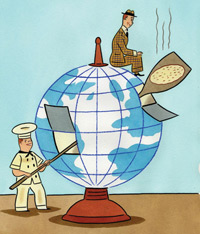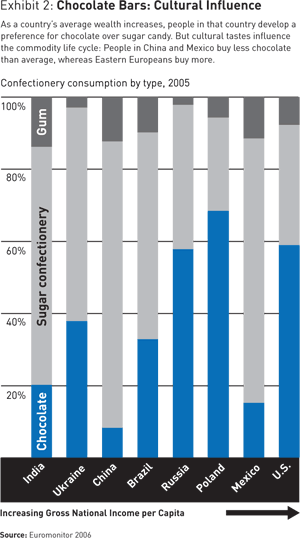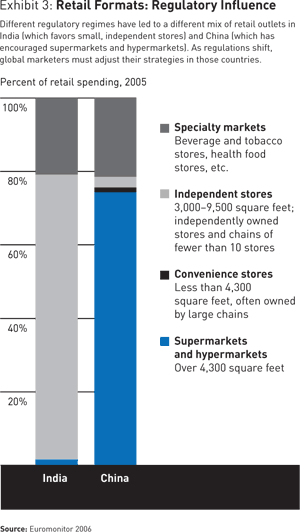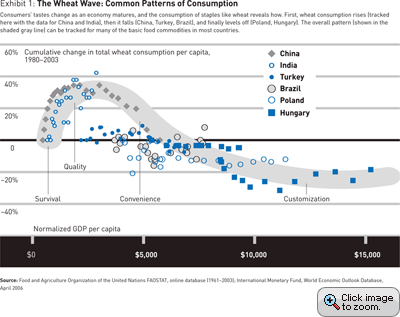The Flatbread Factor
To understand the life cycle of an emerging market, learn to decode its consumer products.
 |
|
Illustrations by Michael Klein |
Gruma’s Shanghai facility is enormous. At the time of its opening in October 2006, it employed 180 people; represented a $100 million investment; and could annually produce 15,000 tons of wheat tortillas, 7,000 tons of corn tortillas, and 6,000 tons of snacks. It found ready customers among Asian distributors in Japan, Korea, Singapore, Hong Kong, Thailand, the Philippines, and Taiwan. And Gruma immediately began sizing up new markets just over the horizon. “In the first stage, we will supply the continental China market, gradually increasing our range to the European and Asian borders of the Middle East. To us, this is a long-term investment that will lead to strategic new business opportunities,” says Roberto Gonzalez Barrera, chairman of Gruma.
Why is a Mexican company with a niche food product like corn flour doing so well in Asia, with plans to expand into the Middle East? The answer lies in a simple yet powerful insight: Markets in emerging countries tend to follow the same path of development. These emerging markets exhibit a natural life cycle — a predictable pattern of consumer demand that is evident in steel, wheat, consumer products, and every other major economic sector. Business leaders who understand this pattern can leverage the similarities from market to market and grow a company accordingly.
By observing the life cycle of emerging markets around the world and recognizing the true advantages of its business model on the global stage, Gruma expertly timed its entry into many countries. Ultimately, its most versatile and marketable product has proven to be not a food, but a process — more specifically, the ability to roll any kind of flour, from corn to wheat to rice, into salable flatbread. Most people from India do not eat corn tortillas, but they do eat a flatbread called naan, made from wheat, which Gruma sells in the United Kingdom and plans to sell in India. The Chinese don’t have much taste for corn tortillas either, but they buy wraps made by Gruma for Peking duck.
Déjà Vu in Global Markets
The companies that use their awareness of the emerging markets life cycle to succeed can be categorized into two types. The first is a growing number of multinational corporations from industrialized nations. They have been spotting opportunities around the globe and planning tactical and strategic decisions accordingly. The second type is like Gruma: formerly local companies from emerging countries with a primarily local or regional market base. These companies are becoming global players in their own right. They accomplish this ascent by applying their instinctive knowledge of emerging markets to extend their reach into other developing countries.
In one week in 2006 in Shanghai, the authors of this article crossed paths with several executives from multinational corporations, each of whom had a Brazilian connection. Some were long-standing multinational executives; their careers at General Electric and Unilever had brought them first to Brazil and now to China. Others were from Bunge and Gerdau, companies with long histories in Brazil that have become multinational enterprises. (Gerdau, for example, is the majority shareholder in the Florida-based company Gerdau Ameristeel, and Bunge is a leading agribusiness and food conglomerate serving worldwide markets.) Although these executives came from different industries, they all saw China the same way. It was producing the same kind of growth they had seen in Brazil after the so-called Brazilian miracle, but at a bigger scale and higher speed. They (and their companies) recognized that the products, business models, and management experience they had developed in Brazil could be valuable in China, too.
Indeed, people involved in global enterprise have a growing feeling of déjà vu: a sense that no matter whether they’re in China, Eastern Europe, or Brazil, they have seen similar market dynamics before. And they have; the life cycle of emerging markets is no figment of the imagination. As global communication and transportation bind the world ever more tightly, global corporations are discovering how relevant their experience can be — as long as they are willing to recognize the current stage of market development in each country they enter, and then adjust their strategies accordingly.
As a country evolves from developing nation to industrialized nation, the population’s basic needs pass through four distinct stages. In developing countries, most of the population is preoccupied with basic survival — obtaining adequate food, shelter, and clothing. (Much of sub-Saharan Africa is in this stage right now.) As a middle class emerges, people seek greater quality in their food, housing, and clothing. (This is currently happening, for example, in much of China and India.) Once a transitioning market’s population can afford relatively high quality, they begin to seek convenience; they buy time-saving appliances and processed foods, and they may move closer to work. (This stage is emerging today in Eastern Europe and Latin America.) Finally, as the market graduates into the realm of developed nations, the population wants customization; with needs for survival, quality, and convenience now met, people will spend a premium (as many do in North America, Japan, and western Europe) to satisfy individual tastes and desires.
Bulk Grain and Melting Chocolate
The maturation of the food value chain provides a clear example. At the survival stage, when people live primarily in rural villages, they grow their own food; they also buy basic carbohydrates such as flour and corn in bulk. Then, as they become slightly more affluent in the quality stage, they shift to basic packaged goods, including some branded staples, and a higher variety of proteins, fruits, and vegetables. At the convenience stage, often after moving to a city and taking jobs there, consumers buy branded processed foods, such as premade tortillas. In a mature economy, customers seek niche products, such as health foods. Every country fits somewhere (perhaps in more than one place) in this evolutionary progression. (See Exhibit 1.)
Although the overall patterns are universal, the evolution of every country is distinct, influenced by its culture and consumer habits. For example, in the confectionery markets, poorer economies tend to prefer sugar candy, which is cheaper and easier to distribute. When economies enter the quality stage, chocolate tends to take over. Yet in Mexico, where chocolate originated, chocolate consumption is low. (See Exhibit 2.)

Several factors are responsible. First, Mexicans generally prefer lemon and chili flavors, which go better with sugar candy than with chocolate. Second, Mexico has a large number of local sugar manufacturers, and the North American Free Trade Agreement prevents high sugar tariffs. These factors create a very competitive market for sugar in Mexico; sugar is priced at 55 percent of the price of chocolate (in comparable countries, the figure is 90 percent). Finally, most of the distribution chain in Mexico lacks refrigeration, and chocolate can melt in transit. If it survives the trip, it may melt at the point of sale — which is dominated by small, independent grocers with poor facilities.
Mexico is thus idiosyncratically disposed against chocolate. But such distinct food preferences, which may add complexity to a company’s market strategy, do not contradict the overall pattern of development.
Better Market Measures
How, then, can decision makers at a multinational corporation recognize which stage in the emerging markets life cycle a given country has reached? The main stumbling block is misleading measurements.
Companies often rely on a country’s average gross domestic product (GDP) as an index of the maturity of a local market. But average GDP, because it aggregates middle-class and poor customers, does not accurately represent a nation’s patterns of development. Thus, it can be a misleading measure for timing a company’s entrance into local markets.
This point is especially critical in countries as massive as China and India. Each of those countries contains distinct regions that should be treated as markets in their own right. The Yangtze River delta, with Shanghai at its center, has a population on par with the largest countries in Europe. And the GDP per capita is much higher there than it is in most other Chinese regions.
Executives should focus instead on four factors in a country’s operating environment:
• Political and Legal Evolution. A country’s regulatory and legal environment has a huge impact on the patterns of development of all industries within its borders.
For instance, India’s government has long imposed laws that protect local mom-and-pop retail stores by barring most foreign direct investment. Large retailers also must negotiate central, state, and local government rules that reflect the country’s long-standing socialist influence.
One 2003 study found that an Indian entrepreneur would need, on average, 15 licenses from 11 government bodies to open a new shop, and securing them would take, on average, six months. Meanwhile, labor laws constrain the growth of large retailers by making it hard to lay off staff. One result: India is a land of 1 billion people and virtually no supermarkets.
Many observers believe that India’s government will lift these regulatory constraints, which would provide huge opportunities for food companies. Reliance Industries, a conglomerate that is India’s largest private-sector enterprise, is already anticipating regulatory liberalization and plans to invest in more than a thousand supermarkets. Meanwhile, Wal-Mart announced in November 2006 a joint venture with Bharti Enterprises, a large Indian company involved in telephony, insurance, and agriculture. The goal: a new chain of Wal-Mart–branded retail stores with Indian ownership.
In China, by contrast, protections for small shopkeepers do not exist, and workers are not allowed to form independent trade unions (a policy set up to keep employment fluid and wages low). Chinese supermarkets and hypermarkets have thus evolved so quickly in 10 years that they already account for 75 percent of the total value of retail sales in the country. From 1994 to 2002, the number of supermarkets in China grew astonishingly fast, from 2,500 to 53,100, according to a report from the Food Industry Center at the University of Minnesota. The net effect is a more mature food and retail market in China than in India, even though India’s middle class emerged earlier. (See Exhibit 3.)

A clear and enforced property-rights system is another critical piece of a country’s legal and regulatory environment. In China and Mexico, persistently high levels of intellectual property infringement have discouraged Microsoft and other companies from rolling out some products. But as laws emerge that hold violators accountable, reduce the supply of low-cost fakes, and spur demand for authentic products, the maturation of Chinese and Mexican technology industries will accelerate as well.
• Infrastructure. The extent, quality, and development of a country’s roads, bridges, ports, and telecommunications — anything that supports physical and informational exchange — deserves close scrutiny. India’s road system, for example, has been severely neglected; traffic congestion, frequent checkpoints, and paperwork add hours of delay. A trip across the country by truck that would take two days on roads like those found in developed nations instead takes a week.
In China, the infrastructure challenges for large retailers such as Wal-Mart are also enormous. China, roughly the size of the contiguous U.S., still doesn’t have a nationwide logistics network of trucks, highways, and warehouses that can efficiently deliver supplies from farm to shop shelf. Refrigerated trucks are scarce, so Wal-Mart often can’t match the fresh produce and low prices found at open-air venues where the Chinese traditionally shop. What’s more, only about one-fifth of China’s freight trucks are containerized, so most cargo is vulnerable to damage on flatbed vehicles. The trade group AmCham-China (the American Chamber of Commerce in China) estimates that transportation and distribution costs make up at least 16 percent of overall product costs in China, compared with less than 4 percent in more developed countries.
Nevertheless, China is rapidly building an extensive higher-quality road network. Infrastructure improvements are also spurring the growth of third-party logistics companies, which are still largely absent in India. The burgeoning logistics industry has a ripple effect, encouraging the entrance of more companies as confidence grows that they can coordinate the storage and movement of their goods around the country.
Anyone seeking to develop a strategy for the fruit and vegetable retail industry in China — or, for that matter, the chocolate industry in Mexico — needs to track the speed at which the infrastructure is changing. Specifically, how soon might refrigerated transportation be available? Wherever it shows up, a more mature market will follow.
The infrastructure can also include such transactional supports as financial and legal services. A strong consumer finance industry can accelerate sales of products as varied as automobiles, white goods, cell phones, and apparel. In South Korea, for example, the rapid rise of consumer financing and information about products and services drove a huge wave of growth. From 1999 to 2002, LG Card, the country’s leading credit card company, boosted card issuance from some 40 million to more than 105 million, translating into a 600 percent increase in total consumer spending.
• Urbanization. As Stewart Brand noted in his article “City Planet” (s+b, Spring 2006), the proportion of humanity living in or near cities is passing 50 percent for the first time in history. In a country like China, where the population of urban dwellers grew by 90 million people between 1999 and 2003, it’s hard to overstate the impact of this trend.
Urban families tend to have two incomes, with both adults working outside the home. This gives consumers more purchasing power, but also less time for food preparation and other household chores. Urban dwellers thus tend to buy more manufactured foods, particularly staples such as bread. Food companies then sell less flour directly to consumers and more in bulk to bakeries. Demand also grows for such personal-care products as shampoos, conditioners, and deodorants. Sales of microwave ovens, refrigerators, and washing machines rise. So do fast-food restaurant revenues, driven by women entering the sales force. (In Shanghai, the average person eats most meals outside the home.)
Urbanization explains why Gruma’s flatbread strategy is so powerful. Flatbread provides a quick and inexpensive meal; thus flatbread is one of the most popular premade food products that new city dwellers purchase.
• Distribution Channels. As an economy evolves, so too do the channels through which consumers purchase products. By anticipating these changes, companies can outmaneuver the competition.
Perhaps the most obvious distribution channel is the retail format, which evolves and converges in very similar patterns across the world. Large formats such as hypermarkets and mass merchandisers have grown quickly in emerging markets. France’s Carrefour SA has become the largest player in both Brazil and China. A Carrefour in Shanghai is similar to one in Sao Paulo, but with added sections for Chinese products such as dumplings, mushrooms, and teas.
Gasoline retailers also follow a near-universal evolutionary arc. First come full-service stations that sell only gas, then stations with convenience stores, and then chains with self-service gas pumps and employees running a retail store.
The skill and education of the local sales force and the customer base also affect maturation. The more expensive or complex the product being sold, the more sophisticated the sales force must be. Retailers such as Home Depot and Lowe’s thrive in Europe and the U.S., where the do-it-yourself approach is prevalent. But in China, people have little experience with home remodeling or repairs, which is why Home Depot entered the market only in 2006 (when it acquired China’s leading home improvement retailer, The Home Way, a chain with just 12 stores).
 The Dual Platform
The Dual Platform
Many senior decision makers in multinational corporations intuitively grasp the life-cycle patterns of the markets they enter. But these insights are rarely translated into a global business strategy.
What would such a strategy look like? That depends on where the strategists come from. Although multinational corporations from the industrialized world see the same opportunities that the energetic new companies from emerging markets see, their challenges are distinct.
Multinationals must devise a strategy for the emerging markets that allows them to prosper while keeping their existing customer base intact. This means creating a dual-platform approach: Keep offering developed markets the existing portfolio of products and services, while adding a distinct and separate set of products and services for emerging markets.
This second platform can’t simply be a cut-rate version; it must be designed as a whole for the emerging market customers, even if the two platforms are both applied within one nation. For example, the automobile industry has historically offered stripped-down versions of its regular car models to consumers in developing markets. In 2004, Renault turned that strategy upside down with its launch of the Logan, a relatively full-featured car selling for less than $10,000. As the Wall Street Journal noted in October 2006, Renault sold 145,000 Logans in the model’s first full year, largely in Eastern Europe and the Middle East; production rapidly expanded from there to Russia, Latin America, and North Africa. In India, Tata Motors is outflanking the Logan with its launch of a $3,000 car — probably the first of many such vehicles aimed at drivers in emerging markets. (See “One Billion New Automobiles,” by Bill Jackson and Vikas Sehgal, s+b, Winter 2006.)
Executives at a global manufacturer of swimming pool equipment grasped this dual-platform concept recently while devising a strategy for the Chinese market. At first the company’s prospects in the country seemed dim because few Chinese have swimming pools. But backyard ponds with koi (ornamental carp) are ubiquitous in China and potentially in need of their own pumps, filters, and accessories. The company is now considering a dual platform in China: a fish pond business alongside its traditional business.
Another example is Cadbury Schweppes PLC, which is extending the successful dual platform that it built in India into other Asian markets. Bharat Puri, regional commercial strategy director at Cadbury, says that the company’s approach hinged on a couple of key insights. First was unit price. It didn’t matter to consumers that buying 25 pieces of chocolate at once was cheaper in the long run than buying a few at a time. The average Indian could afford to buy only in small quantities. After Cadbury began selling a 1-rupee package (equivalent to about 2 cents) that contained four small pieces of chocolate, sales in India doubled in a single year.
After the success of the 1-rupee package, Cadbury tried to increase its gross margins to correspond to its other markets; the company reduced its package size from four chocolates to three, while keeping the price the same. The reaction was swift — an astonishing 85 percent decrease in sales. The lesson: Consumers at every income level recognize and demand value. (Not surprisingly, Cadbury quickly restored the fourth chocolate.)
Another lesson involved finding ways to adapt to local infrastructure. Many Indian retail establishments, like their counterparts in Mexico, lack refrigeration. Cadbury altered its formula so that India’s chocolate has a higher melting point than chocolate sold in Europe. Meanwhile, Cadbury began distributing coolers to retailers in India; it has given away about 100,000 so far.
Finally, Puri says, a company needs to insert itself into the local culture. Eight years ago, chocolate gifts were rare, but today they are popular. Cadbury co-opted a local phrase, “Have something sweet today,” which means have a good day, as its slogan and pushed the idea of chocolate gifts around Diwali, one of the country’s most popular holidays.
Unilever is another multinational corporation with experience operating dual platforms in emerging markets. Thanks to its long history in India, Unilever has a wealth of expertise in developing products and business systems for low-income consumers. It has also developed a dual platform in Brazil, based in part on its 2000 acquisition of the Bestfoods corporation (a producer, active in North and South America, of such staples as mayonnaise and corn oil). Whereas most multinationals focus on the wealthier populations of Rio de Janeiro, Sao Paulo, and the southern states, Bestfoods developed and acquired products and brands (Maizena and Arisco) targeted at lower-income consumers in the poorer but larger states of northeast Brazil.
Unilever’s lower-income platform has allowed the company to develop a formidable presence in both India and Brazil, which positions it to capture the growth in these economies. In turn, by understanding the patterns of development in these countries, Unilever can recognize which strategies, products, and business models it should apply to China and other developing markets.
Emerging Global Entrepreneurs
Meanwhile, the number of global competitors from emerging markets is growing rapidly. These include companies of Latin American origin, like Gruma and Bunge; companies from India, such as automaker Mahindra and Mahindra; and more and more Chinese companies following the examples of Lenovo, Haier, and CNOOC. Companies from emerging markets can leverage a number of competitive advantages. They have privileged access to the resources of their home country (which might include natural resources in Russia or Brazil, a state monopoly in China, or information technology advantages in India). They also have access to low-cost financing from the International Finance Corporation (the private-sector division of the World Bank), as well as Islamic banks and development banks. In addition, they have populations living abroad that are already familiar with their products, and cultural and language ties to many parts of the non-English-speaking world.
But their greatest asset is their expertise, honed through years of production and marketing in home regions. Their products and services are already adapted to the lifestyles of their local customers; their executives are already experts at capturing markets there. The challenge for these companies is learning to adapt their platform externally. They must recognize when their product or business model will fit the stage of the other emerging markets they hope to enter.
Generally speaking, companies from transitioning markets — those accustomed to operating in a free market economy — are in a stronger position to exploit these life cycles than companies recently yoked to socialism. That’s why there are more companies on the global stage from Latin America than from the former Soviet republics. Brazil’s Gerdau, for example, is adapting business models developed over three decades of acquisition and consolidation in Latin America to its enterprise around the world, on a much more accelerated time line. Gerdau is also building its business in the U.S., leveraging its role as the largest producer of nonflat steel in Latin America. Another industrial company, the Argentina-based Techint Group, has leveraged its Latin American experience and sure hand in acquisitions and alliances to sell steel and engineering services in North America, Eastern Europe, and East Asia. (Together, Gerdau and Techint account for almost half of the past five years’ merger and acquisition transaction value in Latin America.)
In Eastern Europe, Bunge has adapted swiftly to the quick commoditization of its core food oil business. Bunge’s Eastern European group, originally a grain trading outfit that moved into oils for the solid profit margins, was forced down the value chain as those oil margins diminished. Leveraging group knowledge from developing markets such as Brazil, as well as local knowledge from acquired companies, Bunge began providing a more sophisticated line of food ingredients, such as dairy fat replacements for use in chocolate and ice cream.
An interesting case from another continent is South African Breweries (SAB). In the 1990s, SAB realized that the beer industry was underdeveloped and poorly managed in many transitioning markets and began an acquisition spree, picking up breweries in other African countries and former Communist nations. In each new market, SAB systematically accelerated the industry’s development pattern to increase per capita consumption and introduce higher-value products. Ultimately it achieved the scale to merge with the U.S.-based Miller Brewing Company, forming a new global company, christened SABMiller. In 2005, when it acquired Grupo Empresarial Bavaria (the Colombia-based brewing company that was the second-largest in Latin America), SABMiller gained dominance over the beer industry in the Andean region, where it intends to replicate its strategy of accelerating the market’s development pattern.
 Competitive Benefits
Competitive Benefits
If your company is expanding into global markets, it should follow a three-step process for creating effective strategies. First, study the conditions in countries where your business already has a presence, or where it hopes to enter. Look for the most effective fit between your business model and the relevant stages of the emerging-market life cycle. An accurate diagnosis can make the difference between jumping in at the right time to grab market share, and being ahead of your time with no market for the product.
PepsiCo Inc. realized its snack food business in Brazil lagged behind its businesses in other Latin American countries because of high costs and poor distribution, not lack of potential demand. By timing its production and distribution investment correctly, Pepsi enjoyed explosive and profitable sales growth.
The advantages of good diagnosis also accrue to companies that correctly anticipate when a product will shift from being an unbranded commodity — typically sold in bulk through fragmented retail channels — to being a branded packaged good. In China, the popular shift from commodity edible oils to branded oils began with the arrival of hypermarkets, supermarkets, and branded convenience stores. The Kerry Group (a Hong Kong–based food and chemicals producer owned by the Malaysia- and Singapore-based Kuok Group) led the way by introducing the brand leader Arawana. Some regional competitors attempted to follow suit, developing brands for major cities such as Shanghai and Guangzhou — the edible oil equivalent of microbrewery beers. However, the delayed entry of these competitors cost them, and most of these local brands have not been profitable. By timing its investment just right, Kerry captured a leadership position in a huge and growing market. Its recent merger with Wilmar International’s edible oil business further enhances that position.
The second step in the process is to use each new market as a laboratory to test new business models against the readiness of different countries. Unilever accomplished this in the 1970s by synthesizing small bars of detergent (called RIN) for use by customers who wanted better ways to clean clothes, but had little discretionary cash and only limited access to running water. Unilever shipped these bars on trucks to the hinterlands of India, creating a substantial business in the process. The company then extended this model to Latin America with its Ala detergent. Designed for laundering by hand, Ala did not need the expensive enzymes that most washing machine detergents included for removing stains.
A more recent example is Coca-Cola Company’s innovative solution to Russia’s ineffective distribution networks. Coca-Cola has begun selling soda right out of shipping containers; it equipped each container with a sales office and arranged to drop off and pick up the containers at sites around the country. If that system proves to be successful, it could be applied in Africa or central Asia.
In Latin America, Germany’s Aldi Group is currently experimenting with a scaled-down supermarket model. It is influenced in part by a 2006 Coca-Cola Retailing Research Council study that found that low-income consumers dislike the hypermarket format and prefer smaller local stores; they don’t have the time or money to travel far to a hypermarket, and they don’t enjoy watching others buy what they can’t afford.
The third step is to leverage your most successful business models in other markets that are reaching similar stages in the life cycle. For example, Pepsi has learned that wine bars in Spain and other countries in western Europe are excellent outlets for its snack foods because bars are frequented by lunch crowds more than in the United States. Pepsi has taken this distribution lesson to its Eastern Europe operations.
Some companies have developed a fast-response-team approach, moving experienced teams to new markets quickly when they spot an evolving industry pattern. Bristol-Myers Squibb Company in Asia sends in marketing and sales executives divided by the channels they are pursuing: The market team for hypermarkets is different from the team serving mom-and-pop stores, because these two channels require different platforms.
Gruma, similarly, deployed a senior “beachhead” team to enter China, with skills honed through many years of experience in Latin America. This team was thus already primed to pick up early signals of market maturity: a decrease in home cooking among dual-career professionals, increasing penetration of fast food chains, an increase in cold storage in supermarkets, and rapid improvements in the logistics and distribution channels.
By studying a market’s natural pattern, regardless of the country, and then viewing that chronology through the prism of that country’s specific context, business managers will have a powerful new way of thinking about emerging and transitional markets. Although it is true that differences from country to country are numerous, these differences should not blind executives to the most significant similarities among markets. It’s by identifying and exploiting the similarities that businesses can gain leverage and success.
The ability to translate these insights into a coherent business strategy is a competitive advantage — and may soon become a competitive imperative as the global business environment opens up to new players. Leading companies from emerging markets are already facing off with multinationals. It’s often said that China will accomplish in 15 years what took Brazil 35 years. Executives will have much less time to react and adapt to the market life cycle as the pace of globalization increases and the ride picks up speed. ![]()
|
What Would Mom and Pop Do? |
|
If you’re looking for innovation in the retail sector in Latin America, don’t go into the high-end stores: Look at what C.K. Prahalad calls the “bottom of the pyramid.” Elektra is the leading electronics and appliances chain in Mexico, with 741 stores and annual revenues of US$1.8 billion. However, because many low-income customers at Elektra make purchases on credit, defaults are a major concern. When a payment is late, therefore, Elektra lets the customer’s neighbors know. It’s a smart form of peer pressure that pays off as the customer pays up. This is an extreme example of the lengths to which some major companies go as they challenge the traditional dominance of small, local stores in low-income areas. A retailer like Elektra has essentially created hundreds of mom-and-pop stores, with one notable difference: They all share the same corporate parent. This model bears watching for companies that have designs on other emerging markets. These retailers understand that the best way to attract consumers in emerging economies is not necessarily with rock-bottom prices. By balancing the need for affordability with the latent aspirations of emerging consumers, these companies have set the bar for other retailers in emerging markets. The consumers they target, who represent 50 percent or more of the population in Latin America, respond enthusiastically to innovations like these: • Better Access to Higher-Level Products or Services. Some successful retailers make it their mission to allow emerging consumers to purchase something that has been previously unaffordable to them (for example, a television or a washing machine). Often this involves creative financing for consumers who have little or no credit history. Some retailers inspire loyalty by offering consumers a level of sales assistance and services, such as extended warranty and home delivery, that they have never gotten from large chains. Others have introduced creative credit-scoring schemes that bring some customers access to credit for the first time. Casas Bahia, the largest household-goods retailer in Brazil, has had revenue growth of approximately 16 percent per year since 1999. It hires sales staff from local communities and trains them to work with customers on buying sensibly, thus encouraging consumers to stay within their budgets — which both reduces the chance of defaults and cuts down on customer frustration. The company has also developed an online central credit system that delegates a significant amount of responsibility to salespeople: Staff members are authorized to give up to 600 reals (approximately $275) in credit to customers who provide a home address and are not blacklisted by the nationwide online credit protection service. Once customers are approved, they can make payments in as many as 18 installments, and will receive further offers of credit after paying off their purchase. Customers must make their payments in person unless they choose to pay an additional fee, which gives Casas Bahia 18 opportunities to strengthen the relationship before the next big purchase. • Affordable Design and Quality. Retailers must often battle the perception held by emerging consumers that if an item is stylish and sold in a trendy store, it’s not for them. Casa & Ideas, a Chilean home decor retailer, performs a careful balancing act between affordable and exclusive. Thanks to a dedicated, in-house design staff of 35 people and a network of suppliers in low-cost countries, the company can put out two collections per year of basic items and between two and four additional collections of limited-edition items. Emerging consumers, happy that a store is specifically aiming to provide them with trendy items, have developed a strong loyalty toward Casa & Ideas; 70 percent of its sales now come from frequent shoppers. • Assortment and Location. Many emerging consumers struggle with the choice between the limited selections at conveniently located small stores and the large selections at chain stores that are difficult to reach because they are only in big cities. Magazine Luiza, a Brazilian retailer of basic home goods, has developed an unusual solution in 52 of its small local “virtual” stores. It makes sure customers can get as many goods as possible not by stocking a broad inventory, but by making its entire catalog accessible at its stores via the Internet. Customers visit the physical storefronts to shop online. Unlike other companies that have failed in that endeavor by employing a self-service model, Magazine Luiza uses sales clerks to educate consumers on the concept. The stores retain a friendly, local flavor by offering an hour of free Internet access to every customer, with an additional hour for those bringing in a new customer. The company also partners with local charities to provide information sessions on such topics as literacy, healthy living, and child care. By making a broad range of products accessible in small towns at the low prices usually available only at large-scale, big-city retailers, companies like these have opened up access to the large market segments of the bottom of the pyramid. Leticia Costa (costa_leticia@bah.com) is a vice president with Booz Allen Hamilton and president of the firm’s office in Brazil. She is an expert on the consumer packaged goods, retail, food and beverage, tobacco, and automotive industries, and currently oversees work with industrials in the Southern Cone. |
|
Tuning In to the M&A Signal |
|
One of the strongest indicators of an emerging nation’s transition to a more robust economy is the merger and acquisition (M&A) activity of the companies headquartered within its boundaries. But executives can also tune in to an earlier signal by analyzing the relative economic value of vertical and horizontal integration within a targeted market sector. In other words, the potential value of M&A activity is itself a leading indicator of when a market is ripe for entry. This indicator can also provide insight about where on a value chain to place investment bets. Mergers and acquisitions are increasingly popular among multinational firms from developing countries. Typically, these companies seek to migrate up the value chain (moving from just manufacturing to conducting their own R&D, and then to marketing and branding their own products), and they can accomplish this by merging with counterparts in other emerging countries — and in industrialized nations as well. In 2005, the overall value of cross-border M&A deals increased by 88 percent, to US$716 billion — and the number of deals increased 20 percent, to 6,134. More and more of the parent companies in these deals come from emerging markets. The total number of companies with corporate parents based in Brazil, China, Hong Kong, India, or the Republic of Korea has grown almost five times since 1993, from less than 2,700 to more than 14,800. But don’t expect all cross-border mergers to be successful. An increase in cross-border activity brings substantial risks for the merging companies. There are a number of reasons that such acquisitions can fail. First, few emerging-market companies have the experience of managing a complicated integration process. Second, complexity increases when transacting firms add affiliates in more locations. Third, cultural, social, and institutional differences lead to higher managerial, governance, and transaction costs. Fourth, managerial capacity is spread thin during integration and coordination activities. Finally, greater geographical breadth means new external risks — such as foreign exchange fluctuations and perhaps political uncertainty — that will have to be managed. Some of the most successful companies from developing countries — including Haier (China), Lenovo (China), Arcelik (Turkey), Ingenuity Solutions (Malaysia), and the pharmaceutical firms Bionova (Mexico) and Cordlife (Singapore) — moved slowly and deliberately, acquiring the capabilities for successful M&A bit by bit. They learned how to manage the integration of new assets through local country partnerships or R&D facilities located in developed countries before they made any substantial acquisitions. They used small steps to increase their presence in a foreign market, and they tended to expand into nearby markets that they already knew. Developing the organizational capabilities for cross-border acquisitions seems to slow things down at first, but the most successful companies have learned that it allows them to move more quickly in the long run, because they don’t have to waste time undoing the damage of a hastily conducted deal. Gerald Adolph (adolph_gerald@bah.com) is a senior vice president in Booz Allen Hamilton’s New York office, where he specializes in mergers, restructuring, and integration. |
Reprint No. 07106
Author profiles:
Alonso Martinez (martinez_alonso@bah.com), a senior vice president with Booz Allen Hamilton based in New York, works with global multinationals and leading Latin American companies, particularly in the consumer products industry. He advises companies on transformation and growth strategies.
Ronald Haddock (haddock_ronald@bah.com) is a vice president and director of Booz Allen Hamilton in Greater China. He works with consumer goods and industrial companies from around the world on strategies for growth and operational effectiveness in the Asia Pacific markets.
Also contributing to this article were Booz Allen Hamilton Senior Associate Andrew Sambrook and Michael Sisk.



